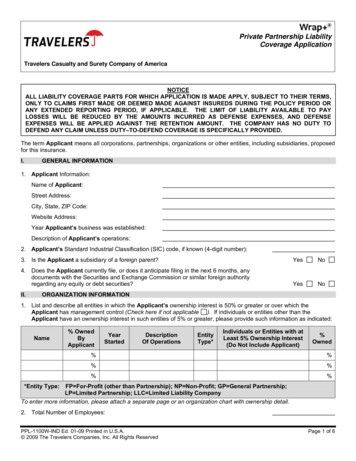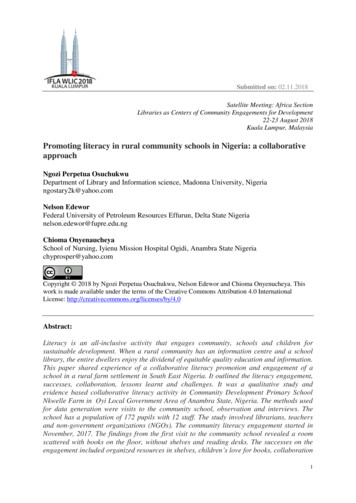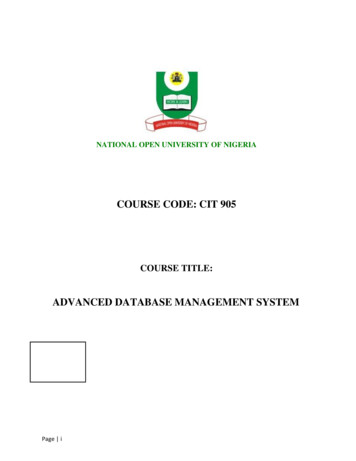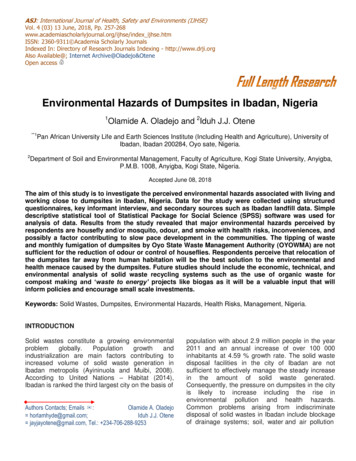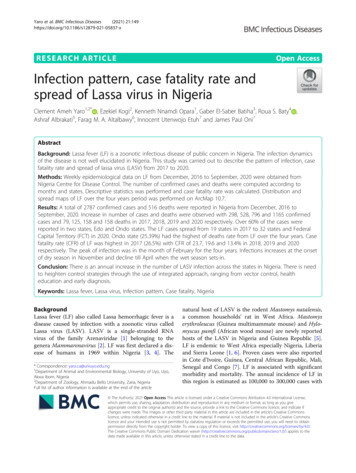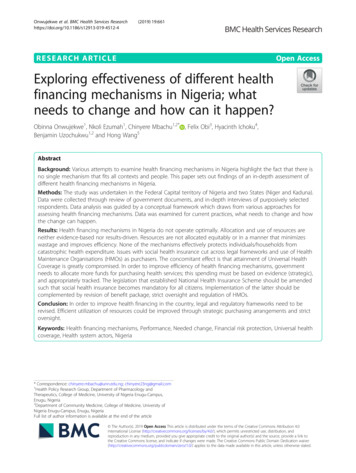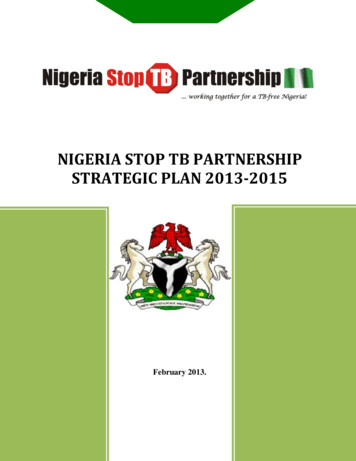
Transcription
NIGERIA STOP TB PARTNERSHIPSTRATEGIC PLAN 2013-2015February 2013.
NIGERIANIGERIA STOPSTOP TBTB PARTNERSHIPPARTNERSHIPSTRATEGICSTRATEGIC PLANPLAN 2013-20152013-2015February 2013.February 2013
ACKNOWLEDGEMENT
PREFACEThe fight against TB must be everybody’s business: from the Ministry of Health to the smallestcommunity-based organization in the rural area; from the Leadership of the country to theordinary person in the village; from the renowned academician to the smallest child in nurseryschool, who is just a potential; from the people infected and affected by TB to the most healthyperson on the street. Nigeria Stop TB Partnership was established to create a massive movementof organizations with individuals committed to the fight against TB in order to “work-our-talk”bolster action and leverage resources for TB elimination by 2050. Specifically, this Partnership isexpected to advocate for the appropriate resources for TB elimination through individual andinstitutional commitments, development partners’ engagement, coordination and harmonization,community mobilization for TB prevention, care and control, mobilization of resources and theengagement of partners in the development, dissemination and adoption of norms for TB controlacross all nooks and crannies of Nigeria.
List of ContributorsDr. Joshua ObasanyaNational Co-ordinator, NTBLCPDr. Baba Gana AdamChairman NSTBP Task Force/National Co-ordinator TB NetworkDr. Ayodele AweWHO NPO-TUB/NIEDr. Shehu LabaranNTBLTC ZariaTony NwosuTEEPAC/Co-ordinator TB Network SE ZoneObatunde OladapoNational Secretary, TB NetworkDr Nneka OnuaguluchiSuccour Foundation, Zankli Medical Centre, AbujaDr. Haruna I. AdamuWHO NPO-TUB/Secretary NSTBPUsman Al-RashidWHO Consultant ACSM
AcronymsACSM-Advocacy, Communication and Social MobilizationAFB-Acid Fast BacilliAIDS-Acquired Immune Deficiency SyndromeBCC-Behaviour Change CommunicationCBO-Community Based OrganizationCDR-Case Detection RateCIDA-Canadian International Development AgencyCPT-Co-trimoxazole Preventive TherapyCSO-Civil Society OrganizationCTBC-Community TB CareDFID-UK Department for International DevelopmentDHS-Demographic and Health SurveyDOT-Direct Observation of TreatmentDOTS-Directly Observed Therapy Short-courseDPT-Department of Public HealthDR-TB-Drug Resistant TuberculosisDST-Drug Susceptibility TestingFCT-Federal Capital TerritoryFMOH-Federal Ministry of HealthGDF-Global Drug FacilityGFTAM-Global Funds to fight AIDS, TB and MalariaGLC-Green Light CommitteeHBC-High Burden CountriesHSS-Health Systems StrengtheningHMIS-Health Management Information SystemIEC-Information Education and CommunicationILEP-International Federation of anti leprosy associationsLACA-Local Action Committee on AIDSMDG-Millennium Development Goal
MDR-TB-Multi Drug Resistant TuberculosisNACA-National Agency for the Control of AIDSNARHS-National HIV/AIDS and Reproductive Health SurveyNASCP-National AIDS & STI Control ProgrammeNGO-Non-Governmental OrganizationNPO-National Professional OfficerNSTBP-Nigeria Stop TB PartnershipNTBLCP-National Tuberculosis and Leprosy Control ProgrammeNTBLTC-National Tuberculosis and Leprosy Training CentreNTS-Nigeria Thoracic SocietyHIV-Human Immuno-deficiency VirusLGA-Local Government AreaPATHS-Partnership for Transforming Health SystemsPEPFAR-Presidential Emergency Funds for AIDS ReliefPHC-Primary Health CarePLHIV-People Living with HIVPPM-Public Private MixPTB-Pulmonary TuberculosisSMOH-State Ministry of HealthSTBLCP-State TB and Leprosy Control ProgrammeTA-Technical AssistanceTB-TuberculosisTBL-Tuberculosis and LeprosyTWG-Technical Working GroupUSAID-United States Agency for International DevelopmentWDC-Ward Development CommitteeWHO-World Health OrganisationXDR-TB-Drug Resistant TB
Table of ContentsACKNOWLEDGEMENT . 3PREFACE. 4List of Contributors . 5Acronyms . 61. OVERVIEW . 9Introduction & Background . 9Governance System. 12Health Systems Structure . 12Global Targets. 15Global Stop TB Strategy . 162. NIGERIA STOP TB PARTNERSHIP STRUCTURE . 17Partners Forum:. 18Technical Working Groups . 233.SITUATION ANALYSIS OF TB IN NIGERIA . 254.NIGERIA STOP TB PARTNERSHIP STRATEGY . 29Vision: . 29Mission: . 29Goal, Targets & Indicators . 29Guiding Principles: . 30Strategic Approach: . 315.PRIORITY AREAS & STRATEGIC OBJECTIVES . 336.STRATEGIC IMPLEMENTATION PLAN 2013 – 2015 . 397.FINANCIAL RESOURCE REQUIREMENT . 468.MONITORING & EVALUATION FRAMEWORK . 499. RISK & ASSUMPTIONS . 54
1. OVERVIEWIntroduction & BackgroundTuberculosis (TB) is an infectious airborne disease and a major global health problem. Globallyeach year, there are around nine million new cases of TB and close to two million deaths. 1 Allcountries are affected, but 85% of cases occur in Africa (30%) and Asia (55%), while India andChina alone represent 35%. There are 22 so-called High Burden Countries (HBC) that account for80% of the world’s TB cases and which have been given particular attention in TB control since2000. These 22 HBC (in alphabetical order) are: Afghanistan, Bangladesh, Brazil, Cambodia,China, the Democratic Republic of Congo, Ethiopia, India, Indonesia, Kenya, Mozambique,Myanmar, Nigeria, Pakistan, the Philippines, the Russian Federation, South Africa, Thailand,Uganda, Tanzania, Viet Nam and Zimbabwe. Globally, the absolute number of TB cases isincreasing slowly due to HIV/AIDS among others. However, the number of per capital (expressedas the number of cases per 100, 000 population) is falling by 1% every year. 2TB is a major public health problem in Nigeria. It is among the ten leading causes of mortalityamong men and women of reproductive age (15 – 49 years) and hospital admissions across publicand private health institutions in the country. Nigeria ranks tenth among the 22 HBC around theworld and the fourth in Africa (after South Africa, Ethiopia and DR Congo). The exact burden of TBdisease in Nigeria (measured as incidence, prevalence, socio-economic indices and mortality) hasnot been properly documented and disseminated. However, according to WHO estimates in 2011,the country has estimated 320,000 cases of all forms of TB with yearly prevalence of 199 casesper 100,000 population and 210,000 new cases representing an incidence rate of 133 per 100,000population.12Global tuberculosis control 2010, World Health Organization, Geneva 2010Lopez AD et al. Global burden of diseases and risk factors. New York. The Work Bank, 2006.
ESTIMATED TB BURDEN IN NIGERIA (2011 WHO GLOBAL TBREPORT)ESTIMATES199 per 100,000 populationEstimated Prevalence rateEstimated Incidence rate (all 131 per 100,000 populationcases)90,311Registered TB cases (all3forms)92%i) All new cases8%ii) Re-treatment cases50%iii) New smear positivecasesiv) Gender Distribution59.3%Males40.7%FemalesAge Distribution of TB casesi) 0 – 15 yearsii) 25 – 44 yearsiii) 45 – 64 yearsTreatment success rateDENOMINATORSAll casesNew casesReported casesReported casesReported casesReported casesNew smear positivesnotified2.8%54%43%84%TB is closely related to HIV & AIDS. TB and HIV constitute lethal combination of diseases thathave individually and collectively made impacts on public health systems, with each making theimpact of the other worse. HIV is the most powerful known risk factor for reactivation of latentTB infection to active disease. The rise in TB cases among People Living with HIV (PLHIV)poses an increased risk of TB transmission to the wider community. TB is the leading cause ofdeath among PLHIV.Nigeria has a national HIV prevalence of 4.1% among pregnant women attending antenatalclinics. 4 The prevalence ranged from 1.0% in Kebbi State to 12.7% in Benue State. OvertimeHIV prevalence in Nigeria has stabilized between 2005 and 2010. This ranged from 4.4% in 200534NTBLCP annual report. FMOH. Abuja. 2008.National HIV sero-prevalence sentinel survey among pregnant women . Technical report. FMOH.2010.
to 4.6% in 2008 and 4.1% in 2010. Based on this, it is estimated that 3.1 million people in Nigeriaare living with HIV & AIDS as at 2010. Report from WHO in 2006 shows that one in every fourHIV patient in Nigeria has TB and accounts for most of their deaths. At TB/HIV co-infection rateof 27%, it estimated that additional burden of 35,200 TB cases annually are added from PLHIV. 5Yet TB is a curable disease. Using combinations of first-line drugs, around 90% of people withdrug-susceptible TB can be cured in six months.As essential component of TB control, the global strategy emphasized the need to empowercommunities and patients affected by TB. Several community Directly Observed Treatment(DOT) models have been implemented in Nigeria to compliment the facility-based DOT. WHO in2000 thus recommended community-based TB care as an effective, acceptable, affordable andcost-effective way to deliver TB DOTS services. 6 Nigeria adopted Directly Observed TreatmentShort course (DOTS) in 1993 and implemented across the thrity-six States and FCT in thecountry. Despite countrywide implementation of DOTS, accessibility to services still remains ahuge challenge as most of the population live some distances from the DOTS centers. Quality ofDOTS services need also to be improved. All these put together has constrained the attainment ofthe national target of TB case detection and treatment success rates. It is expected that increasingawareness of TB and its treatment in communities while making DOTS services more accessibleand acceptable with PHC as the cornerstone of the health system, the attainment of national andglobal targets will be enhanced. Alongside HIV/AIDS is Multi-Drug Resistant-TB (MDR-TB). MDR-TB is yet another mostimportant threat to TB control in Nigeria. According to the 2011 WHO global TB report, theNigeria MDR-TB estimates among notified cases are 2.2% (among new cases) and 9.4% (amongretreatment cases). . Some of the key challenges to MDR-TB treatment include high cost ofsecond-line drugs which are at least 300 times more expensive than first-line drugs based onGreen Light Committee (GLC) prices. Diagnosis of MDR-TB also requires extensive laboratorysystems to conduct culture and drug susceptibility testing (DST); and most importantly are theadverse events associated with second-line drugs.56World Health Organization Global TB Report. 2009.Community TB care in Africa Project (1996 – 2000). WHO Report 2000
Governance SystemThe governance system in Nigeria is structured along the three tier system, each with some levelsof autonomy - Federal, States, and LGAs. The Federal Government is headed by an electedPresident, with two National legislative assemblies – Senate and House of Representatives.Governors provide executive Leadership at State levels. There are thirty-six States spread acrossthe Federation, including the Federal Capital Territory (FCT). Each State has a legislative Houseof Assembly. The third tier of governance is the Local Government Area (LGA) Council. ElectedChairmen provide overall Leadership at the area councils with support from Legislative Council.A total of 774 LGA Councils exits in the federating units of thirty-six States of the FederalRepublic of Nigeria.Nigeria is the most populous country in African with an estimated projected population of 160million people. 7 The landmass of the country is 923,768 square km with about 350 ethnic groups,with diverse languages. The four main ethnic groups are the Hausa Fulani, Igbo and Yoruba. Thetwo predominant religions are Islam and Christianity.Health Systems StructureThe health system in Nigeria is based on the National health policy framework developedapproved by Federal Ministry of Health (FMOH) in 1998 and revised in 2004. The overall goal ofthe policy is to achieve health levels that would enable Nigerians to achieve socially andeconomically productive lives with primary healthcare as its cornerstone. The policy provides fora health system based on primary, secondary and tertiary structures financed, supported andmanaged at LGAs, States and Federal levels respectively. LGA Councils are responsible forprimary level of care, State government for secondary level of care and provision of technicalguidance to the LGAs, and the Federal Government is responsible for the tertiary level of care inaddition to policy formulation and technical guidance to the States.7National Population Commission 2006
Health care services are provided through over 30,000 public and 20,000 private health carefacilities spread across the country. All tertiary and most secondary health facilities have standardlaboratories and the capacity to provide basic laboratory services including Acid Fast Bacilli(AFB) microscopy for identification of Pulmonary TB (PTB). The private sector (both for-profitand non-profit), non-governmental organizations, faith-based organizations, community-basedorganizations and local communities also provide considerable services at all the levels of healthcare including TB care. The private sector provides for more 50% of health care needs of thepopulation in Nigeria.National TB and Leprosy Control Program (NTBLCP)NTBLCP is the responsible agency of the Federal Government that coordinates TB and Leprosycontrol activities in Nigeria. The agency operates as semi-autonomous unit under the Departmentof Public Health (DPH) of the Federal Ministry of Health (FMOH). NTBLCP is structured alongthe three tiers of government-Federal, State and LGAs. The overall goal of NTBLCP is to reducesignificantly the burden, socio-economic impact, and transmission of TB and Leprosy in Nigeria.NTBLCP (otherwise referred to as Central Unit) is responsible for facilitating policy design,development and implementation regarding TB control, support provision of tertiary care,mobilization of resources both locally and internationally, program evaluation and research,human resource development and technical support to State programs. The Leadership atNTBLCP is regarded as the National Coordinator of the entire TB Program in the country. Theinstitution has retinue of supportive medical and paramedical staff. 8The National program has a human development and training center located at Zaria. The centeroften referred to as the National TB and Leprosy Training Centre (NTBLTC) for identifyingvarious HR needs for program implementation and capacity development for various categories ofhealth care staff to implement quality TBL services at Federal, State and LGA levels. The centeralso serves as a referral hospital with about 140 bed capacity for TB and leprosy care.8National Strategic Plan for TB & Leprosy Control 2010 -2015. FMO 2009
In most States in Nigeria, TB control programs are under the Director within the Department ofDisease Control. Other States have autonomous agencies saddled with the responsibilities for TBand HIV control activities. TB control, management, program implementation and supervision arecarried out by the State TBL Control Officer(s) supported by the State TBL Supervisors. TheState TBL programs coordinate TB activities in the respective states, provide secondary care aswell as technical assistance to LGA councils.The Local Government Area is the operational level of the program based on the Primary HealthCare (PHC) principle. At the LGA Level, the TBL Control activities are the responsibility of theLocal Government TBL Supervisors. At this level, PHC workers are involved in carrying outTBL activities in close collaboration with the respective communities and individual engaged inTB control efforts.The National TB Program collaborates with several local and international partners in theplanning, implementation and resource mobilization for TBL control. Key among these are ILEP organizations, UK Partnership for Transforming Health Systems (PATHS), CIDA, USAID,CDC, PEPFAR partners , WHO and CSOs.Successful TB control strategies rely on functioning health systems. The health system is facedwith myriad of challenges such as shortages in health workforce, continuous low levels of publicfunding for health, weak government stewardship functions, weak data management system forevidence-based planning, weak infrastructural facilities, dysfunctional health service networks andimproper coordination of TB control activities from National to LGA levels. It is widelyrecognized that DOTS expansion itself is one facet of health systems development. As such, toinvest in DOTS means investing in improved health systems. However, DOTS expansion withoutstrengthening of the general health services is not sustainable. The Nigeria Stop TB partnershipmust therefore recognize the need to join forces with other stakeholders in health systemsdevelopment to find ways to strengthen human resources for health, increase equitable healthfinancing and improve on general health systems management.
Global TargetsRecognizing the magnitude of the problem, targets for reduction of the burden of TB disease( measured as incidence, prevalence, mortality and socio-economic impact) have been set withintwo global frameworks. These are (1) Millennium Development Goals (MDG) and (2) Stop TBPartnershipGoal 6 of MDG addresses three public health diseases of global importance. This goal aims atcombating HIV/AIDS, Malaria and other related disease which includes TB. In addition, MDGhas specific target (6c) to measure global performance of TB control and two indicators (6.9 &6.10) for this purpose. See Table 1 below.The Stop TB Partnership has two additional targets for 2015. These targets are in shown (in red)in Table 1 below. The MDG target has been endorsed and adopted by the Stop TB Partnership aspart of measurement controls towards the end-line of 2015.Tuberculosis Control in MDGGOAL 6:TARGET 6c:INDICATOR 6.9INDICATOR 6.10Combat HIV/AIDS, Malaria and other diseasesHalt and begin to reverse the incidence of malariaand other major disease including TBIncidence, prevalence and death associated withTB reducedProportion of TB cases detected and curedunder DOTSStop TB Partnership TargetsTarget 1: By 2015Target 2: By 2050Reduce prevalence and death rates by 50%; comparedwith their levels in 1990Eliminate TB as public health problem; defined asGlobal incidence of active TB of less than one case per1 million population per year.
Global Stop TB StrategyWorld Health Organization (WHO) in 2006 launched the Stop TB Strategy as the internationallyrecommended approach to reducing the burden of TB across all countries and in line with globaltargets set for 2015. The overall goal of the strategy is defined as: “To dramatically reduce the globalburden of TB by 2015 in line with the millennium Development Goals and the Stop TB Partnershiptargets.” The Global strategy 9 has six major components:1. Pursue high-quality DOTS expansion and enhancementa. Political commitment with increased and sustained financingb. Case detection through quality-assured bacteriologyc. Standardized treatment with supervision and patient supportd. An effective drug supply and management systeme. Monitoring and evaluation system, and impact measurement2. Address TB/HIV, MDR-TB and other challengesa. Implement collaborative TB/HIV activitiesb. Prevent and control multidrug-resistant TBc. Address prisoners, refugees and other high-risk groups and special situations3. Contribute to health system strengtheninga. Actively participate in efforts to improve system-wide policy, human resources,financing, management, service delivery, and information systemsb. Share innovations that strengthen systems, including the Practical Approach to LungHealth (PAL)c. Adapt innovations from other fields4. Engage all care providersa. Public-Public, and Public-Private Mix (PPM) approachesb. International Standards for Tuberculosis Care (ISTC)5. Empower people with TB and communitiesa. Advocacy, communication and social mobilizationb. Community participation in TB carec. Patients' Charter for Tuberculosis Care6. Enable and promote researcha. Programme-based operational researchb. Research to develop new diagnostics, drugs and vaccines9The Stop TB Strategy: building on and enhancing DOTS to meet the TB-related MDGs. WHO 2006.
2. NIGERIA STOP TB PARTNERSHIP STRUCTUREDiscussions to establish a national partnership began around 2005-2006 but the first formalmeeting was held at the Union Conference in Cape Town in 2007. The partners who wereinvolved at the beginning were the WHO (secretariat), USAID, International Federation of AntiLeprosy Organisations (ILEP), civil society, professional associations, National HIV/AIDScontrol, NTP, a member of the academia (Chair), a member of the private sector (vice chair) andthe affected community. The approach to partnership was chosen keeping in mind the HIV/AIDSapproach of involving multiple stakeholders but all on one common platform. The main goals ofthe partnership are to complement the work of the NTP, advocate for more funding for TB and toincrease awareness and community mobilisation for TB.The partners contribute to TB care and control based on their core competencies andinterests. After determining the skills of each partner, responsibilities within the partnership wereassigned depending on available resources and partners’ capacities. The Ministry of Health,through the NTP provides guidelines and policies while the civil society supports the NTP and
mobilises communities. The private sector also partners with the partnership in many areas,depending on their skills. The members of the affected community play an active role in thepartnership by giving support to TB patients, giving suggestions on quality assurance andinformation sharing to and from the community. An additional benefit of having engaged theaffected communities is the identification of potential new partners. As a result of the suggestionsof the affected communities, community-based organisations and support groups have joined thepartnership and their roles and responsibilities have been integrated into the mapping of partnersto coordinate activities in those communities. Greater coordination of activities of the manystakeholders already supporting the NTP has been the driving force of change.Conceptually, the partnership has been structured to have the following components subject tochange due to the dynamism of the TB control work: Partners’ forum Coordinating Board Working Groups The Partnership SecretariatPartners Forum:The Partners’ forum is the general assembly of the Nigeria Stop TB Partnership (NSTBP) andconsists of an inclusive, consultative meeting of representatives of all partners working directly orindirectly on TB or TB-related diseases. It also includes all those who have interest in TB controlactivities and would help to achieve the goals and aspirations of the Partnership. Some of the keyfunctions of the forum are: To support and reinforce high level political commitment to the objectives of thePartnership and TB control activities in Nigeria. To create, support and implement opportunities for advocacy, information exchange,communication, networking and improved awareness of the Partnership aim. To review overall progress towards implementation of the National, States, LGA and CivilSociety Organizations and Stop TB Partnership plans, review reports presented by theBoard and make recommendations thereafter.
To identify problems and new challenges to the Stop TB Partnership forum and serve asavenue for exchange information of ideas, new knowledge and initiatives. To serve as forum to formalize commitments to Global, National and Partnership targetsand associated strategic plans.Coordinating Board:The Board provides leadership and direction, monitors the implementation of approved policies,plans and activities of the Partnership and ensures coordination among Stop TB Partnershipcomponents.Some of the functions of the coordinating board include: Formulating priority actions by the partnership in line with National health policy,NTBLCP and technical advice from WHO and in line with recommendations of thepartners forum. Support development partners (local and international) and CSOs according to agreedstrategy. Approve the work plan and budget of the Nigeria Stop TB Partnership secretariat; provideleadership, direction and monitor plan implementation. Mobilize adequate resources (human, material, technical and financial) for the variousactivities of the Stop TB Partnership after identifying funding gaps with respect to workplans. Support, coordinate and promote advocacy and social mobilization in support of the StopTB Partnership in appropriate fora. Review progress of work plan implementation of the Stop TB Partnership and maintainhigh quality information exchange including reports of meetings with all Partners and thepublic at large. Support the establishment of the Stop TB Partnership Trust Fund and provide oversight toensure transparency and accountability in the use of the trust fund. Review annual financial statement and progress reports prepared by the ExecutiveSecretary. Develop, adopt and review regularly operational and financial policy and guidelines of thePartnership to underpin accountability for resources entrusted to the Stop TB Partnership.
Coordinate inputs, suggestions and submissions to better the Partnership processes andinitiatives from constituencies within and outside the Board. Represent the Stop TB Partnership in local and international fora and events. Establish committees, working groups and task forces that would aid better performance asit may be necessary. Consider any other matter related to the Stop TB Partnership that might be referred to it byany of its members, Chair of the Board, Executive Secretary, NTBLCP, FMOH, SMOH,Corporate organizations, CSOs, Communities and individuals.Selection of Board members: In order to represent effectively the interests of the Partnership, theBoard must reflect the various constituencies which make up the Partnership. The criteria forBoard members should be commitment to Stop TB, potential to contribute to the success of thePartnership program and relevant skills, knowledge, experience or access to resources. Theprocess of selection should be open and accountable. In that perspective, the election, selection ornomination of members of the Board will be as follows: The constituencies of financial donors, foundations, NGOs / technical agencies and thecorporate sector will organize and carry out, if necessary with the assistance of theSecretariat, an appropriate process of selection and will inform the Board of the processand criteria used. Representatives of States and LGAs, and of communities affected by TB and geo-politicalrepresentatives will be selected by a consultative process managed by the Board. Any organization or IP represented on the Board will nominate their individualrepresentative and inform the Board. The chairpersons of the Working Groups and of the WHO TB Technical Advisors inNigeria will serve as Board members. Board members shall serve for a term of three years and may be re-appointed to a furtherfinal term of three years. At a moment of renewal of the Board, the Chair and the Executive Secretary shall ensurethat the Board undertakes a review of the diversity of skill available on the Board and theexpertise which will be needed in the proximate future. In this task, the Board may be
helped by a consultation (organized by the Secretariat via the website) among the partnersat large to request suggestions on t
STRATEGIC PLAN 2013-2015 . February 2013. NIGERIA STOP TB PARTNERSHIP STRATEGIC PLAN 2013-2015 . February 2013. NIGERIA STOP TB PARTNERSHIP STRATEGIC PLAN 2013-2015 . . FCT - Federal Capital Territory . FMOH - Federal Ministry of Health . GDF - Global Drug Facility . GFTAM - Global Funds to fight AIDS, TB and Malaria .
